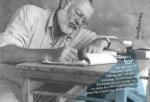EDITING: THE LONG DAY’S JOURNEY TO IMPROVEMENT
I never used to like editing my writing. In point of fact, I didn’t really know how to edit properly.  I was always aware of Hemingway’s scatological description of his first draft although he seems to be working away quite happily in this picture.
I was always aware of Hemingway’s scatological description of his first draft although he seems to be working away quite happily in this picture.
My approach to editing changed when I bought two books by Sol Stein, ‘Solutions for Writers’ and ‘Solutions for Novelists.’ In these he outlined his approach to editing, including a very smart and powerful model using what he calls ‘Triage.’ In this you fix the biggest things first. These include your characters and their motivation, scenes and overall flow of the story. Then you should look at more general points including the language used, the rhythm of the piece, tightening up the story and inconsistencies. Finally you should look at the nuts and bolts of the writing including imprecision of language, confusion in dialogue and things which interrupt the suspension of disbelief.
This is just a quick overview, I’ll say more about Stein’s approach in a later post.
But what is clear is that editing is a long process, that it takes several stages and it can be every bit as creative as the initial writing.
This is the process I use.
My editing takes place even when I’m writing my first draft. I re-read what I wrote the day before and fix anything which needs fixing.
Once I’ve finished my first draft I leave it for a month or so. This leaves me enough space for me to re-read it with fresh eyes.
I read the draft quickly and note down anything which works well and doesn’t work so well. Is the story strong enough? Are the characters’ motivations realistic and clear? Are there any parts where the story is sagging? Are there themes which need to be heightened? Are there any characters who shouldn’t be there or who are missing? Are the chapters and scenes in the right order?
Then I read it through more slowly, looking for weak style, repetitive words, confusion of narrative or dialogue. I often find it useful to read out loud when I come across a troubling part.
I then read the story in a different format. First of all I use the Read function in Word. This puts the manuscript into two pages which is more like a book. It is surprising how different a view this gives. I use this for copy-editing, particularly typos and punctuation errors.
Then I transfer it to my Kindle and read it on this, making any changes as I go along. I may also print it out on paper and look at the manuscript in this format as well.
When I have made all my corrections I give the draft to my wife to read. She is a skilled and tenacious reader. We argue about plot, character and motivation which gives me good ideas on improving the overall shape of the novel. And she has an eagle eye for typos and punctuation mistakes!
I rewrite the manuscript again. I read it on Kindle once more. Then I publish.





